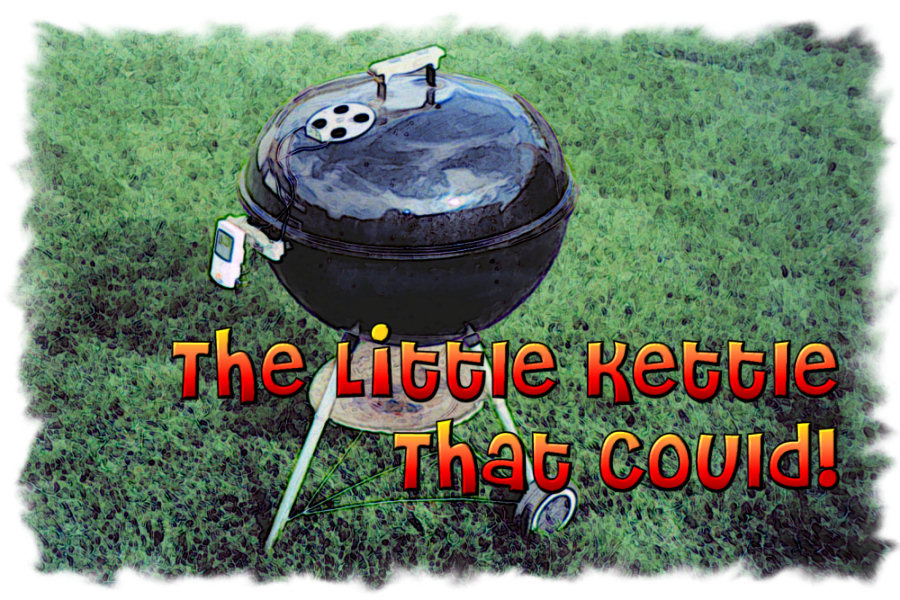

 Our Team
Our Team“The Little Kettle That Could!” competition barbecue team doesn’t exactly exist yet, it’s more of an aspiration to give it a try. When we do figure out how to compete, we’ll be putting up pictures of the trophies here (before we eat them).
 The Eleventh Commandment
The Eleventh CommandmentThou shalt begin thy day with a good butt rub and a long smoke.
 A Tribute to Our Kettle
A Tribute to Our KettleOur barbecue rig is a 22 inch Weber Silver kettle with a hinged grate and with a Smokenator insert and Maverick thermometers. Really basic, relatively cheap, but quite good at turning Boston butts and hickory smoke into tasty pulled pork sandwiches. It also turns out decent ribs and decent brisket too. As a grill it’s great for making burgers, and it does a fine job of planking salmon, and cooking pizza and chicken and potato wedges as well, and even asparagus. Recently we added a PartyQ blower, which is very helpful, and GrillGrates. More recently we swapped the Smokenator for a Slow ’N Sear. All of these things are handy, although the wisest expenditure would have been to spend more originally on a kettle to get the better ash catcher that Weber puts on everything but their base model.
 Paul Wake’s Scientifically Designed and Mathematical Pork Rub
Paul Wake’s Scientifically Designed and Mathematical Pork RubHere is the current state of our own ever evolving and still in need of improvement dry rub. The secret recipe is: 5-3-3-1. Five parts sugar (brown, or brown and white), three parts paprika, three parts salt (kosher or sea if available), and one part pepper (freshly ground is nice), with chili or cayenne, mustard, garlic, onion, celery, lemon, and/or herb powders to taste (perhaps a part per desired addition, although sometimes we do the rub over a slathering of actual mustard). For wet, we go commercial but haven’t settled on a favorite sauce; the only one we’ve found that isn’t made with high fructose corn syrup isn’t as good as some that are.
 A Higher Level of BBQ
A Higher Level of BBQHere in these parts, the boiling point of water is about ten degrees lower than at sea level, due to lower air pressure at altitude. I wondered how that would affect preparing BBQ, so I asked Meathead. He said: “The boiling temp varies with altitude because the air pressure is different and the amount of energy to convert liquid water to gaseous water is less. Air pressure, however, does not affect melting temps or combustion temps. As to cooker temp, 225 is a good number at sea level because moisture in the meat will not evaporate much at that temp because the meat is cold. Since boiling temp is about 10F lower there, you could take the cooker down to 215 to help preserve moisture, but because collagen and fat melting doesn’t change, cooking time will be longer. I’d experiment at 215 and 225 and see which you like. My guess is that 225 will be just fine. Challenging question!”
 Real Pitmasters
Real PitmastersUtah has a number of places to enjoy barbecue. The best known were Q4U in South Kearns, and Pat’s Barbecue in South Salt Lake, both in Salt Lake County. The owner of Q4U actually is a pitmaster, which is more than most barbecue joints have, but he had to replace his restaurant with a BBQ truck. Pat’s Barbecue often has live music—sometimes some good blues—so it’s popular in a trendy way; The Sugarhouse BBQ Company in Salt Lake is similar. Down in Utah County where we live there are some chains, and there was a real BBQ place tucked away in Springville: Charlie Boy’s Pit BBQ, which served up what was probably the best pulled pork sandwich of any restaurant in Utah—no red goop on it at all, just an authentic vinegar and pepper-based sauce and some coleslaw. Unfortunately, it went out of business; Bam Bam’s and Five Star are now filling the gap. Of course, any competition at which Utah BBQ Association members are cooking is likely to be, well, smoking.